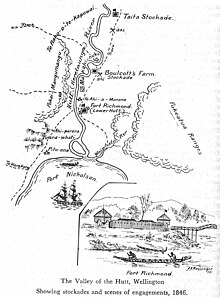| Hutt Valley campaign | |||||||
|---|---|---|---|---|---|---|---|
| Part of New Zealand Wars | |||||||
 Locations of the major engagements of the Hutt Valley campaign | |||||||
| |||||||
| Belligerents | |||||||
|
|
| ||||||
| Commanders and leaders | |||||||
|
|
| ||||||
| Units involved | |||||||
|
|
| ||||||
The Hutt Valley campaign was an armed conflict in the lower North Island of New Zealand between indigenous Māori and British settlers and military forces in 1846. The campaign was among the earliest of the 19th century New Zealand Wars that were fought over issues of land and sovereignty. It was preceded by the Wairau affray (June 1843) and followed by the Wanganui campaign (April–July 1847) and was triggered by much the same pressures—the careless land purchasing practices of the New Zealand Company, armed government support for settler land claims, and complex intertribal tensions between local Māori. The three conflicts also shared many of the same combatants.
The campaign's most notable clashes were the Māori dawn raid on an imperial stockade at Boulcott's Farm in the Hutt Valley on 16 May 1846 in which eight British soldiers and at least two Māori died, and the Battle of Battle Hill from 6–13 August as British troops, local militia and kūpapa Māori pursued a Ngāti Toa force led by chief Te Rangihaeata through steep and dense bushland. Ngāti Toa chief Te Rauparaha was taken into custody during the campaign; he was detained without charge in Auckland for two years.[3]
A 2003 report by the Waitangi Tribunal concluded the New Zealand Company's 1839 land purchases were invalid and that the Crown committed a number of breaches of the 1840 Treaty of Waitangi in subsequent dealings with Māori in the area.
- ^ Cite error: The named reference
NZ18460207.2.10was invoked but never defined (see the help page). - ^ Collinson, Thomas Bernard (1855). "2. Continuation of the Remarks on the Military Operations in New Zealand" (PDF). Papers on Subjects Connected with the Duties of the Corp of Royal Engineers. New Series 4. London: John Weale: 22–50.
- ^ Oliver, Steven. "Te Rauparaha". Dictionary of New Zealand Biography. Ministry for Culture and Heritage. Retrieved 26 June 2019.